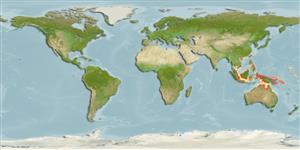Environment: milieu / climate zone / depth range / distribution range
Écologie
marin; saumâtre benthopélagique. Tropical
Western Pacific: northern Australia and southern New Guinea.
Taille / Poids / Âge
Maturity: Lm ? range ? - ? cm
Max length : 39.5 cm SL mâle / non sexé; (Ref. 30691)
Épines dorsales (Total) : 1; Rayons mous anaux: 22 - 25. Body coppery, golden brown, bronze or greyish pink. Dorsomedian head groove deep and elliptical posteriorly. Long barbels with maxillary pair 30 - 56% of SL; bases of chin barbels well separated and staggered. Gill rakers largely absent from hind aspect of the first 2 gill arches. Dorsal fin spine with a short filament at all ages (Ref. 38478).
Inhabits coastal waters and estuaries, river deltas and rivers within tidal influence. Feeds mainly on prawns and other crustaceans, fish, aquatic insects, plant material, and fish scales taken opportunistically (Ref. 38478).
Life cycle and mating behavior
Maturité | Reproduction | Frai | Œufs | Fécondité | Larves
Kailola, P.J., 1999. Ariidae (=Tachysuridae): sea catfishes (fork-tailed catfishes). p. 1827-1879. In K.E. Carpenter and V.H. Niem (eds.) FAO species identification guide for fishery purposes. The living marine resources of the Western Central Pacific. Vol. 3. Batoid fishes, chimaeras and bony fishes part 1 (Elopidae to Linophrynidae). FAO, Rome. (Ref. 38478)
Statut dans la liste rouge de l'IUCN (Ref. 130435: Version 2024-1)
Menace pour l'homme
Traumatogenic (Ref. 58010)
Utilisations par l'homme
Outils
Articles particuliers
Télécharger en XML
Sources Internet
Estimates based on models
Preferred temperature (Ref.
123201): 26.7 - 29, mean 28 °C (based on 298 cells).
Phylogenetic diversity index (Ref.
82804): PD
50 = 0.5156 [Uniqueness, from 0.5 = low to 2.0 = high].
Bayesian length-weight: a=0.00490 (0.00250 - 0.00959), b=3.13 (2.96 - 3.30), in cm total length, based on LWR estimates for this (Sub)family-body shape (Ref.
93245).
Niveau trophique (Ref.
69278): 3.7 ±0.4 se; based on diet studies.
Résilience (Ref.
120179): Milieu, temps minimum de doublement de population : 1,4 à 4,4 années (Preliminary K or Fecundity.).
Fishing Vulnerability (Ref.
59153): Moderate vulnerability (38 of 100).
